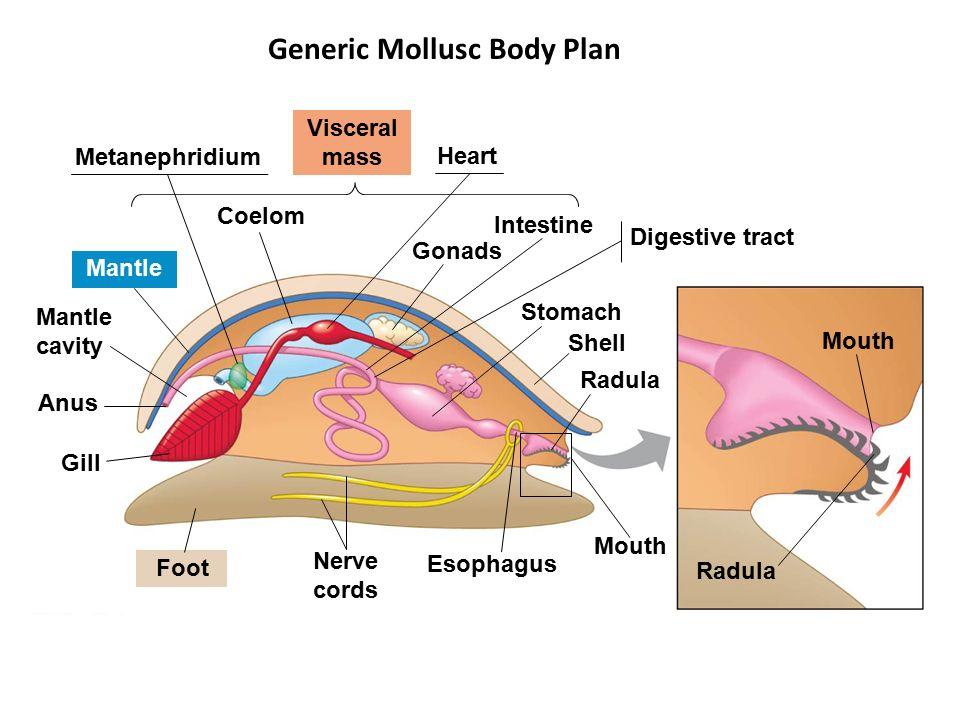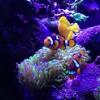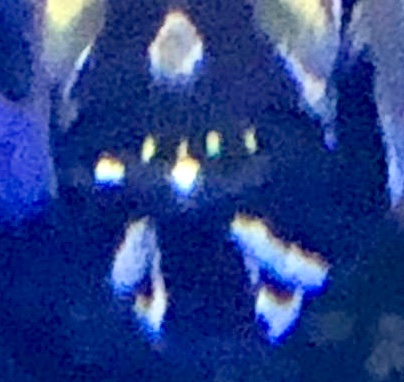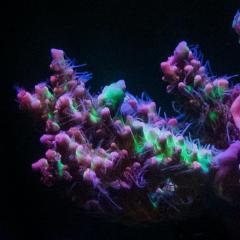Leaderboard
Popular Content
Showing content with the highest reputation on 05/02/2021 in all areas
-
A couple more pics of diatoms They are in fact beneficial and always present in a balanced tank system. According to Wikipedia, diatoms in the ocean generate 20% of the oxygen produced on the planet each year. Diatoms are a form of photosynthetic single cell phytoplankton. While some reefers hate it, here are some fun facts on diatoms Diatoms take up silicic acid from the water to form a silica shell (a form of glass). Sources of silicon : silica sand/quartz sand (from the beach), tap water, marine salt mix Diatom chloroplasts (i.e. plant cell organelles that convert light energy into chemical energy via the photosynthetic process) are yellowish brown due to the presence of photosynthetic pigments such as chlorophyll (green), beta carotene (orange), and fucoxanthin (orange) Cell walls made of silica (glass). Their exoskeleton are made of 2 halves that fit inside one another perfectly. The walls are called frustules and have 2 main shapes – longish shape (called Pennate) and disc/cylindrical shape called centric) Diatoms are beneficial – they can outcompete the growth of other types of algae. And prevent HAB (Harmful Algae Bloom) – green water, cyanobacteria bloom, dinoflagellates Copepods eat phytoplankton (including diatoms) which in turn feed the fish Note that once silicates are depleted, other forms of algae can appear. Hence a good balance is required. Silica are in fact critical for the reef aquarium. Normal levels are 0.02ppm - 2.9ppm. Marine organisms that use silica : Marine sponges (beneficial filter feeder) incorporate silicates in their structure. Some mollusks (snails) have radula (teeth) to scrape off algae from rocks/glass. These teeth contain substantial silica. And of course, diatoms - benefits mentioned above. Credit : Pic from https://socratic.org/ In any case, if diatoms are a bother, especially when silica levels are elevated beyond the normal levels mentioned earlier, consider the following : 'Export' the silicates by siphoning out the diatoms when they form. Don't just stir or turkey baster it off the rocks/sand bed Use aragonite sand instead of quartz/silica sand Avoid using tap water. ICP test of tap water at Bt Batok has 1.12ppm of silicon. Use a good RODI filter to prepare water for water change & top up Use resins such as Rowaphos (and probably other similar products). These remove plenty of phosphates but also some level of silicates.3 points
-
1 point
-
1 point
-
1 point
-
All these few sps colonies are really nice and good size. $100 each. Sent from my SM-G988B using Tapatalk1 point
-
Time for Otaku update Previously my male banggai cardinal stop eating and i suspect brooding kids in mouth, sure enough after 20 days he go into labour on labour day [emoji23] Can see the baby fish eyes in the mouth [emoji102] Zoom in, sorry for crap photos, my skills bad [emoji23] cute baby banggai fry, Good father, the mother just throw the job to dad and he completed without fuss, 20 days straight no food..sakhi...its not always about the good mums, good dads are around too [emoji23] Realized banggai cardinal is endangered species only available in indonesia, hope can help propagate this species. Thanks for reading and happy reefing! Sent from Singapore Reef Club mobile app1 point
-
1 point
-
The problem of colormetric tests is that it tends to be rather subjective. They are also rather dependent on ambient light conditions. I would not worry too much at this stage. Just let your tank take its pace to cycle. Do ghost feed a bit though. Because we not only want to build up nitrifying bacteria, we also want bacteria which help to decompose other organics.1 point
-
Forgotten Heros Part 2: Diatom Filters Imagine if you will a filter that is so fine it can polish your saltwater removing even bacteria. That, my fellow reefers is a diatomaceous earth (aka Diatom) filter. Now, the funny thing about a diatom filter is that, well, it isn't a filter per se. [Huh??] It is actually a natural powder made form fossilised algea (diatoms). The powder is added to a filter to reduce the size of the pores of that filter and is equivalent of adding millions of microscopic 'bio balls'. These microscopic particles (which are actually fossilised diatom shells) contain two holes, one that is approximately 3 micron in diameter and another 'inner pore' which is roughly 0.5micron in size. As such it's natural shape provides it with an ability to trap microscopic elements, producing simply stunning cleansing power. However, with such cleaning power this filter can easily get clogged up, as it basically polishes everything out of the water column. Hence running one aftee a series of progressively finer sediment filters or some fine carbon is recommended. There are special external diatom filter systems from likes of marineland, votrex, haywood that you can buy, or you can easily DIY using an rodi type filter as a base (a quick Google will return many designs). Either version allow you to add the powder to an existing filter solution. Unlike other weird and wonderful chemicals the diatomaceous earth powder is readily available (try pool supply shops). Note that there are two grades of powder; food grade or filter grade. Rich reefers tend to select food grade as it is more pure (risk of contaminants is lower) but there is still some debate on if it's really necessary, just make sure is 100% pure. Talking of the powder this stuff is super fine so you do not want to be breathing it into your lungs the use with a good N95 mask is recommended. (You can also wet down the powder a little). Whilst they have fallen out of fashion (reefer amnesia?) these filters are still widely used in the the pool cleaning, food and beverage industries where most Beer manufacturers use them. Now this is good news, as these 'filters' have continued to be refined overtime and have subsequently evolved since the 1980's when they were popular additions to aquariums. As such modern alternatives to the powder now exist in the form of Ceramic Diatomite Filters. These ceramic filters are now so fine it is possible to get them down to 0.1microns (to put that in perspective that is 2000 times more filtration power then your average reef sock!). They can be used just like a normal 10 inch filter or you can buy them in bricks. Either way they can be easily installed on the reef tank with an appropriate housing. These filters are not super expensive (sub $15) and work extremely well, too well infact, stripping everything haha. So keeping them clean is as mentioned a challenge plus you may need to supplement if you run them alot. Although the modern ones are reusable, my experience is that you can only reuse them effectively a few times and expect the same flow rates. However, the good news is that used ones can potentially be repurposed as bio media. So if you want to super-polish your water, drastically reduce the impact of an ich outbreak (free floating stage), use as part of a water recycling system or just want to experiment with powders / ceramics and a cool new piece of gear, maybe you will consider using a Diatom or the more modern Diatomite filter going forward(?). I wonder if anyone here is using them?? Either way, Happy Reefing!! Sent from Singapore Reef Club mobile app1 point
-
Renovation is underway! And the tank is delivered! By the way, I opt for a galvanized iron frame to allow full access (without pillar) to my sump. Probably doable if you opt for aluminum frame too. Well my carpenter keep telling me it’s challenging to build the carpentry for a hooded tank. Realised so as I see them trying to fit the suspended hood to the tank like a glove. The almost completed carpentry for the display tank. Looks pretty much like how I imagined it. The air vent is also designed to allow circulation without allowing light from the tank to be “exposed” on the exterior. With the carpentry almost up, next up in action would be the trusty crew from Tank Culture. They had quite a tough time working in confined spaces to fulfill a rather demanding piping job.. And seriously, I thought they did an amazing job with the setup and piping work. Everything looks neat and professional! Sent from my iPhone using Tapatalk1 point
-
Quick update Sold Hydra 64 with light fixture Nero 5 Teco tk2000 Available 160l water drum with float valve Rodi unit Nyos 220 Vectra L2 return pump Tank set Sent from my iPhone using Tapatalk1 point
-
There could be various reasons. But one likely one is that it is bleaching due to excessive light. Gonio generally prefer low light conditions. From the picture, it seems to be placed at a location that's bright enough for SPS/Monti. Perhaps its too bright. Would suggest to bring it to a more shaded spot.1 point


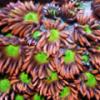
.jpg.01d37f9c47e3e800d25bbd48c46cd663.jpg)
.jpg.e4e209add4a34a6b87b3f5ef4a1ecb99.jpg)
